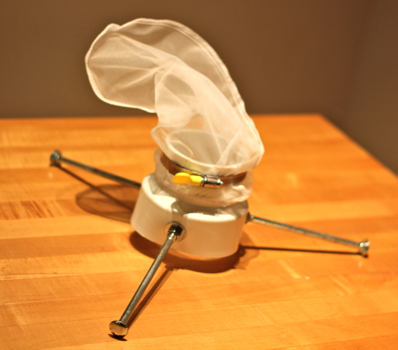 |
| BYO's hop spider |
One simple invention that has come along since then is the hop spider. For those who haven't heard of these, the retain pellet hops in the boil, reducing the amount of trub you have to deal with post-boil and preventing clogging of your system. The classic hop spider is a 4" to 3" PCV coupler with 3 or 4 carriage bolts sticking out of the wide portion and a fine mesh bag held onto the bottom with a screw-clamp (see image above). While a brilliant invention, I've always disliked them for two reasons - the get in the way of the lid, and the sized bag usually used concentrates the hops; IMO, likely reducing alpha acid extraction efficiency. Moreover, it doesn't let you adapt to different sized batches in your brewpot.
My hop spider (details below the fold) overcomes these issues - and costs less to build to boot!
My Spider:
|
| My hop spider is based on a slightly different design; in place of the small bag usually used to hold the hops I have a 60cm x 60cm (roughly 24"x24") brew-in-a-bag bag. The fine mesh should keep the hops out of the pot body, while the large size will allow the hop-bag to fill a large portion of the pot. As with normal hop-spiders, the hop-bag is held onto my spider with a worm-clamp. A second difference in my hop spider is how I attach it to the pot. Rather than carriage bolts I am using a narrow-gauge wire that I have twisted into a braid (for stiffness). The wire is attached (left-side of image) through a hole drilled in the edge of the 4" to 3" PVC coupler. This small wire, in place of the bolts, lets the position of the spider be altered in the pot, as well as lets the lid sit tightly when heating wort while first-wort hopping. |
|
| As you can see in the image to the left, the wire fits snugly around the lip of the pot and attaches to one of the pots handels. The hop-bag fills most of the volume of the pot. |
|
| By wrapping the wire around the pots handle the spider is held firmly in place. This allows the easy re-positioning of the spider, in order to maximize the volume of wort the hops are suspended in, between batches of different sizes, or even during a long boil when the volume change is large. |
|
| Hop-spider in action! |




Great solution, totally stealing your design.
ReplyDeleteHey Brian,
ReplyDeleteYou might consider using a different plastic for the body of your spider- PVC is made with some pretty nasty stuff and is not considered food safe at higher temperatures (I think above 170F-ish?). Safety issues with most plastics are overblown in my opinion, but PVC is one I am a bit more cautious about. HDPE would be best, there are a bunch that would work. That being said, there are probably bigger worries in life.
- Dennis, Life Fermented Blog
As designed, the PVC never touches the wort so any issues are minimal. None-the-less, I used cPVC (US term; here in Canada all PVC must be cPVC), meaning it must be hot-water rated. cPVC is chlorinated and doesn't leach out the nasty stuff normal PVC does at higher temps. It will warp above 93C, but won't leach.
DeleteExcuse my ignorance, but how do you avoid a bag of this size scorching on the bottom of your kettle?
ReplyDeleteSo long as you don't heat the kettle dry it should be OK - I brewed my last batch of beer with this spider and had no issues with the bag (or wort) scorching.
DeleteIf you frequently have issues with wort scorching I'd recommend you take efforts to rectify that before using a bag like mine - I'm not certain it would scorch, but I also wouldn't want to make a batch of burnt-plastic lager to find out...